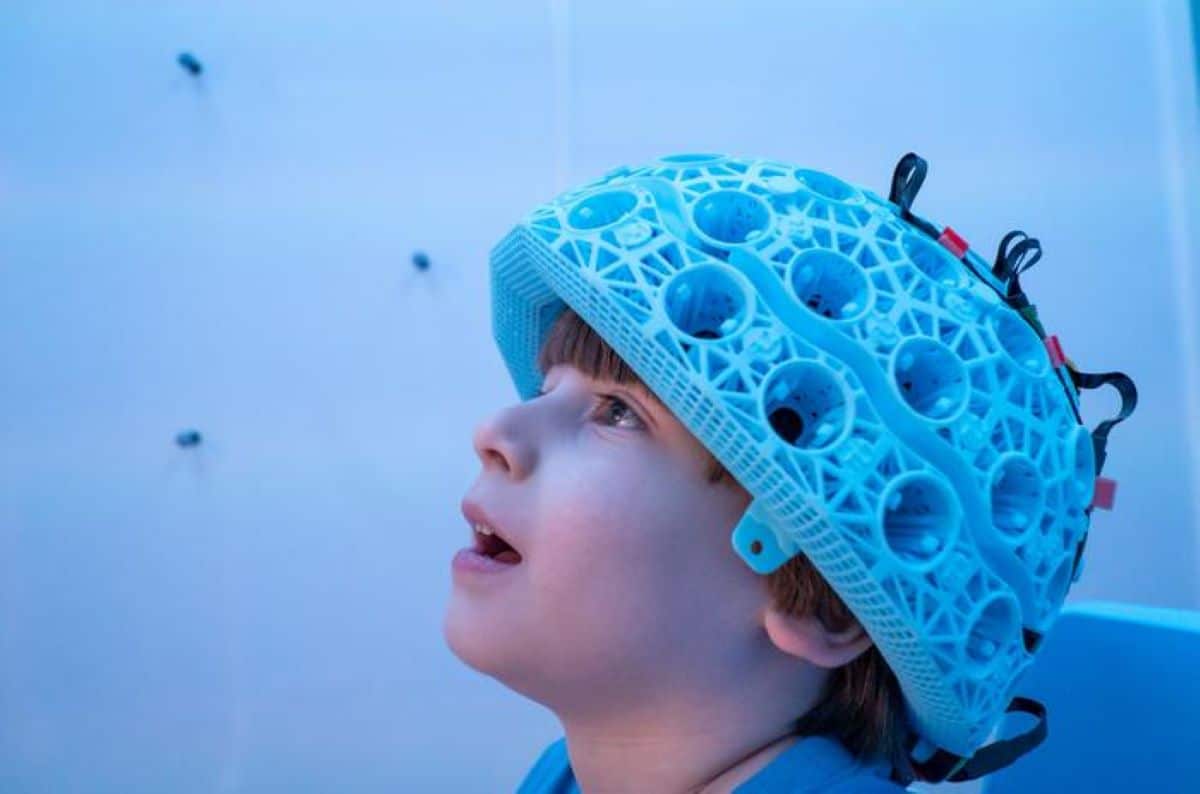Summary: Researchers used a wearable MEG scanner to map brain activity in young children, providing new insights into brain development and conditions like autism. The lightweight, adaptable helmet with quantum technology allows for high-quality, movement-friendly scanning. This breakthrough enables the study of crucial developmental milestones and brain function from a very young age.
Key Facts:
- Wearable MEG scanner maps brain activity in children as young as two.
- Quantum technology allows for high-quality, movement-friendly scanning.
- Study provides insights into developmental milestones and autism.
Source: University of Nottingham
New research has given the clearest ever picture of young children’s developing brains, using a wearable brain scanner to map electrical brain activity. The work opens up new possibilities for tracking how critical developmental milestones, like walking and talking, are underpinned by changing brain function, and how neurodevelopmental conditions like autism emerge.
The research team, led by scientists from the University of Nottingham’s School of Physics and Astronomy, used a novel design of magnetoencephalography (MEG) scanner to measure brain electrophysiology in children as young as two.

The findings have been published in eLife.
Brain cells operate and communicate by producing electrical currents. These currents generate tiny magnetic fields that can be detected outside the head.
Researchers used their novel system to measure these fields, and mathematical modelling to turn those fields into high fidelity images showing, millisecond-by-millisecond, which parts of the brain are engaged when we undertake tasks.
The wearable brain scanner is based on quantum technology, and uses LEGO-brick-sized sensors – called optically pumped magnetometers (OPMs) – which are incorporated into a lightweight helmet to measure the fields generated by brain activity.
The unique design means the system can be adapted to fit any age group, from toddlers to adults. Sensors can be placed much closer to the head, enhancing data quality. The system also allows people to move whilst wearing it, making it ideal for scanning children who find it hard to keep still in conventional scanners.
27 children (aged 2-13 years) and 26 adults (aged 21-34 years) took part in the study, which examined a fundamental component of brain function called ‘neural oscillations’ (or brain waves). Different areas of the brain are responsible for different aspects of behaviour and neural oscillations promote communication between these regions.
The research team measured how this connectivity changes as we grow up, and how our brains use short, punctate bursts of electrophysiological activity to inhibit networks iof brain regions, and consequently to control how we attend to incoming sensory stimuli.
The work was jointly led by Dr Lukas Rier, and Dr Natalie Rhodes from the University of Nottingham’s School of Physics and Astronomy.
Dr Rier said: “The wearable system has opened up new opportunities to study and understand children’s brains at much younger ages than was previously possible with MEG.
“There are important reasons for moving to younger participants: from a neuroscientific viewpoint, many critical milestones in development occur in the first few years (even months) of life. If we can use our technology to measure the brain activities that underpin these developmental milestones, this would offer a new understanding of brain function.”
The research, which was funded by the Engineering and Physics Research Council (EPSRC), included academic collaborators from SickKids Hospital in Toronto, Canada, and industry partners from US based atomic device company QuSpin and Nottingham based company Cerca Magnetics Limited.
Dr Rhodes was a University of Nottingham undergraduate student in Physics, and a postgraduate student when the work was carried out.
She has now moved to a postdoctoral position in Toronto, and explains: “This study is the first of its kind using wearable MEG technology and provides a platform to launch new clinical research in childhood disorders. This means that we can begin to explore not only healthy brain development, but also the neural substrates that underlie atypical development in children.”
World renowned neuroscientist Dr Margot Taylor – also an author on the paper – is leading research into autism in Toronto.
She said: “Our work is dedicated to studying brain function in young children with and without autism. This study is the first to demonstrate that we can track brain development from a very young age. This is hugely exciting for possible translation to clinical research and work such as this help us understand how autism develops.”
The University launched a spin-out company Cerca Magnetics in 2020 to commercialise OPM-MEG scanners and related technologies. The wearable system has been installed in a number of high profile research institutions across the globe, including SickKids hospital in Toronto.
The research teams in both institutions are now working together to expand the amount of neurodevelopmental data, on both healthy and atypical brain function.
About this neurotech and neurodevelopment research news
Author: Emma Thorne
Source: University of Nottingham
Contact: Emma Thorne – University of Nottingham
Image: The image is credited to University of Nottingham
Original Research: Open access.
“The neurodevelopmental trajectory of beta band oscillations: an OPM-MEG study” by Lukas Rier et al. eLife
Abstract
The neurodevelopmental trajectory of beta band oscillations: an OPM-MEG study
Neural oscillations mediate the coordination of activity within and between brain networks, supporting cognition and behaviour.
How these processes develop throughout childhood is not only an important neuroscientific question but could also shed light on the mechanisms underlying neurological and psychiatric disorders.
However, measuring the neurodevelopmental trajectory of oscillations has been hampered by confounds from instrumentation.
In this paper, we investigate the suitability of a disruptive new imaging platform – optically pumped magnetometer-based magnetoencephalography (OPM-MEG) – to study oscillations during brain development.
We show how a unique 192-channel OPM-MEG device, which is adaptable to head size and robust to participant movement, can be used to collect high-fidelity electrophysiological data in individuals aged between 2 and 34 years.
Data were collected during a somatosensory task, and we measured both stimulus-induced modulation of beta oscillations in sensory cortex, and whole-brain connectivity, showing that both modulate significantly with age.
Moreover, we show that pan-spectral bursts of electrophysiological activity drive task-induced beta modulation, and that their probability of occurrence and spectral content change with age.
Our results offer new insights into the developmental trajectory of beta oscillations and provide clear evidence that OPM-MEG is an ideal platform for studying electrophysiology in neurodevelopment.






